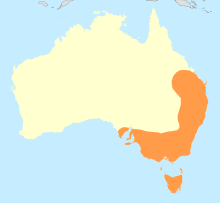| Superb fairywren | |
|---|---|

| |
| Male in breeding plumage subspecies cyanochlamys | |

| |
| Female – Victorian High Country | |
| Scientific classification | |
| Domain: | Eukaryota |
| Kingdom: | Animalia |
| Phylum: | Chordata |
| Class: | Aves |
| Order: | Passeriformes |
| Family: | Maluridae |
| Genus: | Malurus |
| Species: | M. cyaneus
|
| Binomial name | |
| Malurus cyaneus (Ellis, 1782)
| |
| Subspecies | |
|
6, see text | |

| |
| Superb fairywren range | |
| Synonyms | |
| |
The superb fairywren (Malurus cyaneus) is a passerine bird in the Australasian wren family, Maluridae, and is common and familiar across south-eastern Australia. It is a sedentary and territorial species, also exhibiting a high degree of sexual dimorphism; the male in breeding plumage has a striking bright blue forehead, ear coverts, mantle, and tail, with a black mask and black or dark blue throat. Non-breeding males, females and juveniles are predominantly grey-brown in colour; this gave the early impression that males were polygamous, as all dull-coloured birds were taken for females. Six subspecies groups are recognized: three larger and darker forms from Tasmania, Flinders and King Island respectively, and three smaller and paler forms from mainland Australia and Kangaroo Island.
Like other fairywrens, the superb fairywren is notable for several peculiar behavioural characteristics; the birds are socially monogamous and sexually promiscuous, meaning that although they form pairs between one male and one female, each partner will mate with other individuals and even assist in raising the young from such pairings. Male wrens pluck yellow petals and display them to females as part of a courtship display.
The superb fairywren can be found in almost any area that has at least a little dense undergrowth for shelter, including grasslands with scattered shrubs, moderately thick forest, woodland, heaths, and domestic gardens. It has adapted well to the urban environment and is common in suburban Sydney, Canberra, Melbourne and Brisbane. The superb fairywren eats mostly insects and supplements its diet with seeds.
The superb fairywren was named 'Australian Bird of the Year' for 2021, after a survey conducted by Birdlife Australia saw the species narrowly defeat the tawny frogmouth with a margin of 666 votes (over 400,000 votes were cast in total).[2]
- ^ BirdLife International (2016). "Malurus cyaneus". IUCN Red List of Threatened Species. 2016: e.T22703736A93934554. doi:10.2305/IUCN.UK.2016-3.RLTS.T22703736A93934554.en. Retrieved 19 November 2021.
- ^ "Superb fairywren crowned 2021 Australian bird of the year winner in hotly contested vote". the Guardian. 2021-10-08. Retrieved 2021-10-24.
